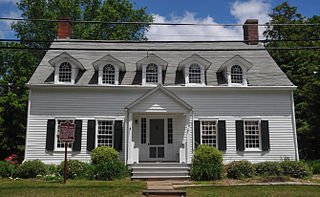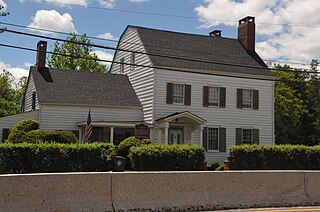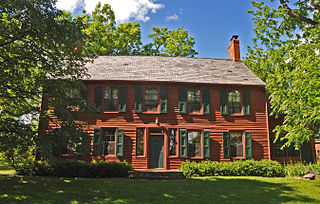
Morris County is a county located in the U.S. state of New Jersey, about 30 mi (48 km) west of New York City. According to the 2020 census, the county was the state's tenth-most populous county, with a population of 509,285, its highest decennial count ever and an increase of 17,009 (+3.5%) from the 2010 census count of 492,276, which in turn reflected an increase of 22,064 (+11.6%) from the 470,212 counted at the 2000 Census, Morris County is part of the New York metropolitan area and is divided into 39 municipalities, with many commuter towns but no large cities. Its county seat is Morristown, in the southeast. The most populous place was Parsippany-Troy Hills Township, with 56,162 residents at the time of the 2020 census, while Rockaway Township covered 45.55 square miles (118.0 km2), the largest total area of any municipality.

Route 10 is a 23.51 mi (37.84 km) state highway in the northern part of the U.S. state of New Jersey. It runs from an intersection with U.S. Route 46 in Roxbury Township, Morris County, east to County Route 577 /CR 677 in West Orange, Essex County. Route 10 is a major route through northern New Jersey that runs through Ledgewood, East Hanover, and Livingston. It is a four-lane highway for most of its length with the exception of the easternmost part of the route. Route 10 features intersections with many major roads including Route 53 and US 202 in Morris Plains and Interstate 287 (I-287) in Hanover Township.

East Hanover Township is a township in Morris County, in the U.S. state of New Jersey. As of the 2020 United States census, the township's population was 11,105, a decrease of 52 (−0.5%) from the 2010 census count of 11,157, which in turn reflected a decline of 236 (−2.1%) from the 11,393 counted in the 2000 census.

Hanover Township is a township in Morris County, in the U.S. state of New Jersey. As of the 2020 United States census, the township's population was 14,677, an increase of 965 (+7.0%) from the 2010 census count of 13,712, which in turn reflected an increase of 814 (+6.3%) from the 12,898 counted in the 2000 census. The township comprises the unincorporated communities of Whippany and Cedar Knolls.

Parsippany–Troy Hills, commonly known as Parsippany, is a township in Morris County, in the U.S. state of New Jersey. As of the 2020 United States census, the township's population was 56,162, an increase of 2,924 (+5.5%) from the 2010 census count of 53,238, which in turn reflected an increase of 2,589 (+5.1%) from the 50,649 counted at the 2000 census.

Passaic River is a river, approximately 80 miles (130 km) long, in Northern New Jersey. The river in its upper course flows in a highly circuitous route, meandering through the swamp lowlands between the ridge hills of rural and suburban northern New Jersey, called the Great Swamp, draining much of the northern portion of the state through its tributaries.

The Whippany River is a tributary of the Rockaway River, approximately 20 mi (30 km) long, in northern New Jersey in the United States.

County Route 511 is a county highway in the U.S. state of New Jersey. The highway extends 37.44 miles (60.25 km) from Columbia Avenue in Morris Township to the New York state line in West Milford where the road continues as New York State Route 210.

The Whippany Railway Museum is a railway museum and excursion train ride located in the Whippany section of Hanover Township in Morris County, New Jersey, United States.

The First Church of Hanover, also known as the First Presbyterian Church of Hanover or the Hanover Presbyterian Church, is located on Mount Pleasant Avenue in East Hanover, Morris County, New Jersey, United States. Established in 1718 in what was then the British Province of New Jersey, it is a member of the Presbyterian Church (USA) and is the oldest religious congregation in Morris County. The congregation's current building, constructed in 1835, is listed on the National Register of Historic Places.
Troy Hills is a census-designated place (CDP) in the township of Parsippany-Troy Hills, Morris County, New Jersey, United States. It is in the southeast part of the township, bordered to the north and west by the Parsippany CDP, to the south by Whippany in Hanover Township, and to the east by Troy Meadows, the largest freshwater marsh in New Jersey.

Morristown and Erie Railroad Whippany Water Tank is located in Hanover Township, Morris County, New Jersey, United States. The water tank was built in 1904 by the Morristown and Erie Railroad and was added to the National Register of Historic Places on September 6, 2006.
The Northwest Jersey Athletic Conference (NJAC) is a sports league that includes 39 public and private high schools from Morris County, Sussex County and Warren County, New Jersey, that operates under the auspices of the New Jersey State Interscholastic Athletic Association.

The Patriots' Path is a multi-use trail system in Morris County, New Jersey, open to cyclists, hikers, and horseback riders, consisting of a 55-mile (89 km) main trail and 35 miles (56 km) of spur trails. The main trail is marked with white blazes or a white circular blaze with a brown tree. The spur trails are marked with blue blazes or a white circle with a blue tree, while the side spur trails are marked with a red blaze or a white circle with a red tree.

Troy Meadows is a 3,100-acre (1,300 ha) nature preserve in Parsippany, Morris County, New Jersey. Along with the Great Swamp, it is one of the remnants of Glacial Lake Passaic. It was designated a National Natural Landmark in 1967. It is the largest freshwater marsh in New Jersey, the Whippany River goes through the swamp before connecting with the Rockaway River. It is part of the Northeastern coastal forests ecoregion.

Morristown & Erie Railway is a short-line railroad based in Morristown, New Jersey, chartered in 1895 as the Whippany River Railroad. It operates freight rail service in Morris County, New Jersey and surrounding areas on the original Whippany Line between Morristown and Roseland, as well as the Morris County-owned Dover & Rockaway Branch, Chester Branch, and High Bridge Branch. The M&E also operated the Maine Eastern Railroad from November 2003 to December 31, 2015.
The Buried Valley Aquifer System is a buried valley aquifer in the central basin of the Passaic River watershed in New Jersey, as defined by the U.S. Army Corps of Engineers and U.S. Environmental Protection Agency. This region impacts drinking water sources for twenty-six municipalities in four northern New Jersey counties: Morris, Union, Essex, and Somerset.

Neepaulakating Creek is a 2.4-mile long (3.8 km) tributary of Papakating Creek in Wantage Township in Sussex County, New Jersey in the United States. It is one of three streams feeding the Papakating Creek, a major contributor to the Wallkill River. Although the stream was dammed in the 1950s to create Lake Neepaulin as the focal point of a private residential development, the stream did not receive a name until 2002. Residents chose a name that combined elements of the names "Neepaulin" and "Papakating", and submitted a proposal to the United States Board of Geographic Names. The name was approved in 2004.

Lake Neepaulin is a small man-made freshwater lake located in Wantage Township in Sussex County, New Jersey in the United States. Located in the watershed of Papakating Creek, a tributary of the Wallkill River, the lake was created in the 1950s by damming an unnamed mountain stream as the feature of a private residential development. The stream, now known as Neepaulakating Creek, did not receive a name until 2002.

New Jersey Water Pollution Control Law consists of legislative and regulatory measures intended to limit the amount of harmful substances found in the state's lakes, rivers, and groundwater. In New Jersey, the federal Clean Water Act and the state Water Pollution Control Act are the most significant pieces of water pollution control legislation. These laws are implemented and enforced by the New Jersey Department of Environmental Protection (NJDEP).
















